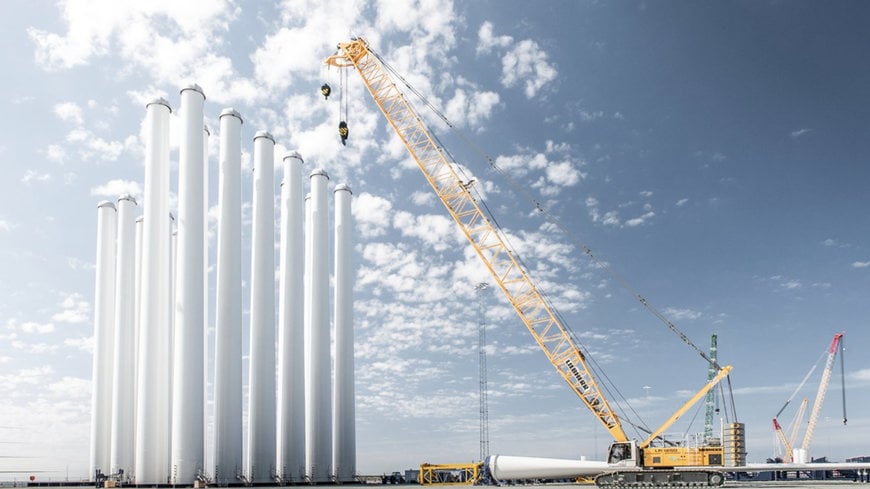www.industryemea.com
24
'24
Written on Modified on
VESTAS INTRODUCES ARCELORMITTAL’S LOW CARBON-EMISSIONS STEEL OFFERING FOR WIND TURBINES
A partnership between Vestas and ArcelorMittal will deliver XCarb recycled and renewably produced heavy plate steel to an offshore wind farm in Poland.

© Vestas
Vestas, has established a partnership with ArcelorMittal to launch a low carbon-emissions steel offering that significantly reduces the lifetime carbon dioxide emissions from the production of wind turbine towers.
The low carbon-emissions steel is produced using 100% steel scrap which is melted in an electric arc furnace powered by 100% wind energy at the ArcelorMittal steel mill, Industeel Charleroi, in Belgium. The steel slabs are then transformed into heavy plates used for the manufacture of wind turbine towers, at ArcelorMittal’s heavy plate mill in Gijón, Spain.
These heavy plates, made with XCarb® recycled and renewably produced heavy plate steel, are initially suitable for the entire onshore wind turbine towers and the top section of offshore wind turbine towers. The low carbon-emissions heavy plate steel has an Environmental Product Declaration (EPD), certified by an independent party, detailing the complete environmental footprint of the product, and allowing easier comparison between products. ArcelorMittal is the only steel producer to produce low-carbon emissions heavy plate steel in large dimensions (up to 18 tonnes), minimising the need for welding and associated CO₂ emissions.
By utilising low carbon-emissions steel in the top two sections of an offshore tower, this emissions reduction translates to a 25% reduction in emissions compared with a tower made from steel produced via the conventional steelmaking route. For an entire onshore tower, the CO₂ reduction is at least 52%.
Commitment from Baltic Power wind farm
Steel and iron constitute 80-90% of a wind turbine's material mass, and approximately 50% of a turbine’s total lifecycle emissions. With the partnership with ArcelorMittal, Vestas has taken an important step forward to reduce CO₂ emissions occurring in its supply chain and can achieve a 66% decrease in emission intensity per kg steel compared with steel made via the conventional steelmaking route.
Even though the low carbon-emissions steel is not yet a standard offering from Vestas, the first project using low carbon-emissions steel will be the Baltic Power offshore wind farm off the coast of Poland. During 2025, Vestas will start the construction of the offshore wind farm, expected to generate up to up to 1.2 GW and ultimately supply clean electricity to more than 1.5 million households in Poland. Vestas will supply, install, and commission 76 V236-15.0 MW wind turbines for the Baltic Power project. Around 52 towers out of 76 will be made with low carbon-emissions steel.
Vestas, has established a partnership with ArcelorMittal to launch a low carbon-emissions steel offering that significantly reduces the lifetime carbon dioxide emissions from the production of wind turbine towers.
The low carbon-emissions steel is produced using 100% steel scrap which is melted in an electric arc furnace powered by 100% wind energy at the ArcelorMittal steel mill, Industeel Charleroi, in Belgium. The steel slabs are then transformed into heavy plates used for the manufacture of wind turbine towers, at ArcelorMittal’s heavy plate mill in Gijón, Spain.
These heavy plates, made with XCarb® recycled and renewably produced heavy plate steel, are initially suitable for the entire onshore wind turbine towers and the top section of offshore wind turbine towers. The low carbon-emissions heavy plate steel has an Environmental Product Declaration (EPD), certified by an independent party, detailing the complete environmental footprint of the product, and allowing easier comparison between products. ArcelorMittal is the only steel producer to produce low-carbon emissions heavy plate steel in large dimensions (up to 18 tonnes), minimising the need for welding and associated CO₂ emissions.
By utilising low carbon-emissions steel in the top two sections of an offshore tower, this emissions reduction translates to a 25% reduction in emissions compared with a tower made from steel produced via the conventional steelmaking route. For an entire onshore tower, the CO₂ reduction is at least 52%.
Commitment from Baltic Power wind farm
Steel and iron constitute 80-90% of a wind turbine's material mass, and approximately 50% of a turbine’s total lifecycle emissions. With the partnership with ArcelorMittal, Vestas has taken an important step forward to reduce CO₂ emissions occurring in its supply chain and can achieve a 66% decrease in emission intensity per kg steel compared with steel made via the conventional steelmaking route.
Even though the low carbon-emissions steel is not yet a standard offering from Vestas, the first project using low carbon-emissions steel will be the Baltic Power offshore wind farm off the coast of Poland. During 2025, Vestas will start the construction of the offshore wind farm, expected to generate up to up to 1.2 GW and ultimately supply clean electricity to more than 1.5 million households in Poland. Vestas will supply, install, and commission 76 V236-15.0 MW wind turbines for the Baltic Power project. Around 52 towers out of 76 will be made with low carbon-emissions steel.
www.arcelormittal.com

